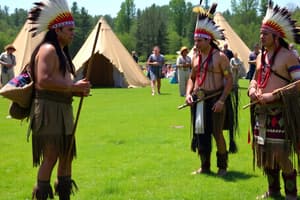Podcast
Questions and Answers
What determined when the Haudenosaunee people relocated their villages?
What determined when the Haudenosaunee people relocated their villages?
- Religious ceremonies dictated the movement to new lands.
- Seasonal changes in weather patterns.
- The depletion of farmland's ability to produce crops. (correct)
- Trade routes shifted, requiring a more strategic location.
Which of the following best describes the Haudenosaunee?
Which of the following best describes the Haudenosaunee?
- A group of European settlers.
- A society that focused primarily on maritime trade.
- A nomadic group that followed buffalo herds
- A confederacy of First Nations known for their agriculture. (correct)
What main factor influenced the Haudenosaunee's village life and structure?
What main factor influenced the Haudenosaunee's village life and structure?
- The need for protection from storms.
- Availability of specific types of wood for longhouse construction.
- Fertility of the land for agriculture. (correct)
- Proximity to major waterways for trade.
The Haudenosaunee are also known by what other name?
The Haudenosaunee are also known by what other name?
Besides agriculture, how else did the Haudenosaunee sustain themselves economically?
Besides agriculture, how else did the Haudenosaunee sustain themselves economically?
Which nations were part of the Six Nations Confederacy?
Which nations were part of the Six Nations Confederacy?
Based on the information, how did the Haudenosaunee balance their diet?
Based on the information, how did the Haudenosaunee balance their diet?
What role did agriculture play in the sustainability of Haudenosaunee villages?
What role did agriculture play in the sustainability of Haudenosaunee villages?
If a new archaeological discovery revealed that the Haudenosaunee had extensive irrigation systems, what would be the most logical conclusion?
If a new archaeological discovery revealed that the Haudenosaunee had extensive irrigation systems, what would be the most logical conclusion?
Why is it important to still recognize and understand Haudenosaunee history and culture today?
Why is it important to still recognize and understand Haudenosaunee history and culture today?
Which statement best explains the relationship between the 'three sisters' and the Haudenosaunee's long-term settlement patterns?
Which statement best explains the relationship between the 'three sisters' and the Haudenosaunee's long-term settlement patterns?
How effective were the protective walls surrounding the Haudenosaunee villages?
How effective were the protective walls surrounding the Haudenosaunee villages?
Why is it significant that the Haudenosaunee are still in existence today?
Why is it significant that the Haudenosaunee are still in existence today?
Flashcards
Who were the Haudenosaunee?
Who were the Haudenosaunee?
The Haudenosaunee, also known as "People of the Longhouse," were part of the Six Nations Confederacy.
Six Nations of Confederacy
Six Nations of Confederacy
Mohawk, Onondaga, Oneida, Cayuga, Seneca, and Tuscarora.
What were the 'three sisters'?
What were the 'three sisters'?
Corn, beans, and squash, known as the "three sisters," were the main crops.
Haudenosaunee Economic Activities
Haudenosaunee Economic Activities
Signup and view all the flashcards
Haudenosaunee village structure
Haudenosaunee village structure
Signup and view all the flashcards
Why villages moved?
Why villages moved?
Signup and view all the flashcards
Study Notes
- The Haudenosaunee, also known as "People of the Longhouse," were previously called Iroquois by European settlers.
- They are part of the Six Nations Confederacy, which includes the Mohawk, Onondaga, Oneida, Cayuga, Seneca, and Tuscarora nations.
- The provided content covers the Haudenosaunee people's life between 1713-1800.
Economic Activity
- The Haudenosaunee were known for their agricultural skills, planting corn, beans, and squash, which are known as "the three sisters."
- They also gathered berries and nuts as well as hunted and fished.
- They lived in villages of a few or many longhouses, surrounded by protective walls, housing up to several hundred people in one village.
- Villages were moved when the farmland no longer produced good crops.
Studying That Suits You
Use AI to generate personalized quizzes and flashcards to suit your learning preferences.




